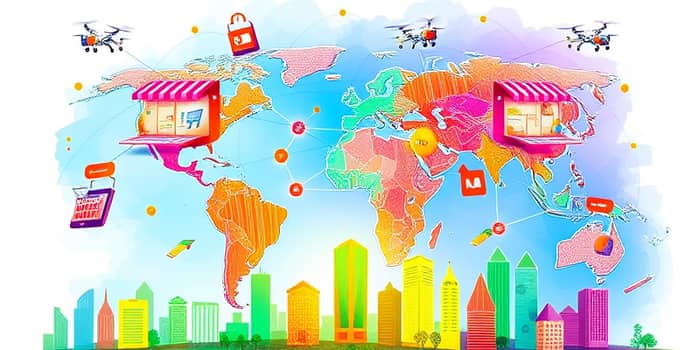
The global retail landscape has been irrevocably transformed by the events of the past few years. From corner shops to multinational brands, businesses have had to adapt to a new reality where digital channels reign supreme.
The pandemic served as a catalyst for rapid pandemic-driven digital transformation, pushing consumers and retailers online at an unprecedented pace. According to industry forecasts, global e-commerce sales projected to reach $6.88 trillion by the end of 2025, marking a seismic shift in how goods are bought and sold worldwide.
By 2025, e-commerce is expected to represent 21% of global retail sales, climbing even higher to 22.6% by 2027. This growth is no longer just a temporary pandemic-driven sales surge, but rather a steady climb fueled by sustained growth driven by evolving consumer behaviors and the ease of setting up online storefronts.
While e-commerce growth is universal, it is particularly concentrated in a handful of leading regions. Together, China, the United States, and Western Europe account for 80% of global sales. Below is a breakdown of market dominance as of 2023:
China led the charge with $935.14 billion in e-commerce revenue, while the U.S. followed closely at $910.39 billion. Regions such as India and the Philippines are not far behind, with projected sales growth rates of 22.3% and 24.1% respectively for 2024, signaling the rise of a cross-border e-commerce frontier for growth.
The United States remains a powerhouse in online retail, with estimated e-commerce sales of $1.47 trillion in 2025—a 9.78% increase from 2024. As of Q4 2024, online channels accounted for 17.9% of all U.S. retail sales, demonstrating consumers’ growing preference for digital convenience.
Within this ecosystem, a few platforms have emerged as clear leaders. Market share estimates for 2025 highlight the concentration of power:
Amazon’s dominance is further underscored by its advertising spend of $1.7 billion—more than four times that of Walmart—creating a virtuous cycle where increased visibility translates into ever-larger market share.
Even as the world transitions to a post-pandemic era, consumer habits shaped during lockdowns continue to influence retail strategies. Approximately 41% of Americans now shop online at least once a week, compared to 27% in the U.K. The rise of buy online, pick up in store (BOPIS) options underscores shoppers’ desire for seamless, omnichannel experiences.
Retailers have leveraged data-driven commerce and personalized marketing to convert browsers into buyers. By capturing detailed customer preferences, brands can deliver targeted promotions and curated product recommendations, enhancing loyalty and lifetime value. Special offers, flash sales, and subscription models have also become vital tactics in retaining attention in a crowded digital marketplace.
The democratization of e-commerce technology has lowered barriers to entry, giving rise to more than 30.7 million online stores worldwide—up from 24 million in 2022. Platforms like Shopify, Etsy, and Amazon FBA provide entrepreneurs with out-of-the-box solutions for storefront setup, payment processing, and fulfillment.
Small businesses now represent 70% of the e-commerce universe, each generating less than $1 million in annual revenue. In a market where saturation is high, differentiation through operational efficiency, automation, and customer experience is essential.
Successful operators are investing in best-in-class e-commerce CMS and SaaS solutions to enable rapid scaling and uninterrupted service as they blend physical and digital channels. Key competitive strategies include:
Cross-border e-commerce is poised for explosive growth. With sales projected to reach $1.9 trillion in 2024 and potentially $3.37 trillion by 2028, global brands and small businesses alike are seizing the opportunity to tap into new markets. Advances in international shipping, local payment methods, and multilingual support are reducing friction in cross-border transactions.
Looking ahead, the intersection of augmented reality, AI-driven personalization, and voice commerce promises to redefine customer engagement. As the industry matures, we can expect greater emphasis on sustainable fulfillment practices, circular commerce models, and the integration of blockchain for enhanced transparency.
In the post-pandemic era, e-commerce is no longer an optional channel—it is the cornerstone of modern retail. From global giants to niche startups, success hinges on adaptability, data-driven strategies, and an unwavering focus on the customer experience. As platforms continue to innovate and competition intensifies, the winners will be those who can seamlessly blend technology with human-centric service, charting a course toward the next frontier of digital commerce.
References













